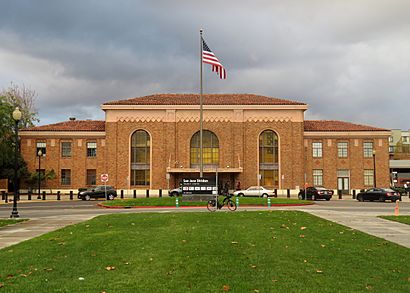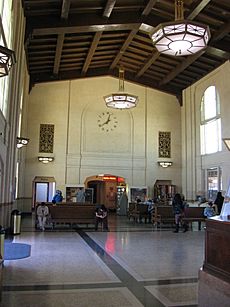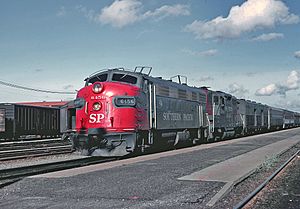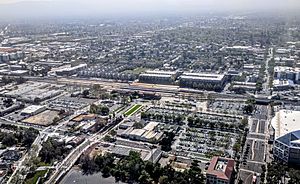San Jose Diridon station facts for kids
Quick facts for kids
San Jose Diridon
|
|||||||||||||||||||||||
|---|---|---|---|---|---|---|---|---|---|---|---|---|---|---|---|---|---|---|---|---|---|---|---|

San Jose Diridon station in November 2019
|
|||||||||||||||||||||||
| Location | 65 Cahill Street, San Jose, California | ||||||||||||||||||||||
| Coordinates | 37°19′48″N 121°54′11″W / 37.330°N 121.903°W | ||||||||||||||||||||||
| Owned by | Peninsula Corridor Joint Powers Board | ||||||||||||||||||||||
| Line(s) | Peninsula Subdivision | ||||||||||||||||||||||
| Platforms | 1 side platform, 4 island platforms (Amtrak/Caltrain/ACE) 2 side platforms (VTA Light Rail) |
||||||||||||||||||||||
| Tracks | 9 (Amtrak/Caltrain/ACE) 2 (VTA Light Rail) |
||||||||||||||||||||||
| Connections | |||||||||||||||||||||||
| Construction | |||||||||||||||||||||||
| Parking | $5.50 per day (Caltrain only) | ||||||||||||||||||||||
| Bicycle facilities | Racks available | ||||||||||||||||||||||
| Disabled access | Yes | ||||||||||||||||||||||
| Other information | |||||||||||||||||||||||
| Station code | SJC (Amtrak) | ||||||||||||||||||||||
| Fare zone | 4 (Caltrain) | ||||||||||||||||||||||
| History | |||||||||||||||||||||||
| Opened | December 1935 August 1, 2005 (VTA Light Rail) |
||||||||||||||||||||||
| Opening | 2029–2030 (BART) | ||||||||||||||||||||||
| Rebuilt | 1994 | ||||||||||||||||||||||
| Previous names | Cahill Depot | ||||||||||||||||||||||
| Original company | Southern Pacific | ||||||||||||||||||||||
| Traffic | |||||||||||||||||||||||
| Passengers (2018) | 4,876 (weekday average) (Caltrain) | ||||||||||||||||||||||
| Passengers (2018) | 230,387 (annual) |
||||||||||||||||||||||
| Rank | 20th in California (Amtrak) | ||||||||||||||||||||||
|
|||||||||||||||||||||||
|
|||||||||||||||||||||||
|
Southern Pacific Depot
|
|||||||||||||||||||||||
| Built | 1935 | ||||||||||||||||||||||
| Architect | John H. Christie | ||||||||||||||||||||||
| Architectural style | Italian Renaissance Revival | ||||||||||||||||||||||
| NRHP reference No. | 93000274 | ||||||||||||||||||||||
| Added to NRHP | April 1, 1993 | ||||||||||||||||||||||
San Jose Diridon is a big train station in San Jose, California. It's a main spot for trains and buses in Santa Clara County and Silicon Valley. The station is named after Rod Diridon, a former leader in Santa Clara County.
You can find the station on Union Pacific tracks at 65 Cahill Street in San Jose. The building is special because of its Italian Renaissance Revival style. It's even listed on the National Register of Historic Places!
Many different trains use this station. These include Caltrain, ACE, VTA light rail, and Amtrak trains. The station also has a bus area. Here you can catch buses like Amtrak Thruway Motorcoach, Greyhound, Megabus, and VTA buses.
Soon, Bay Area Rapid Transit (BART) trains will also come here. A new underground BART station is planned to open around 2029–2030. This will be part of the Silicon Valley BART extension.
Contents
Station Design and Style
The station building looks like the Italian Renaissance Revival style. It has a tall, three-story middle part. On each side, there are two-story sections. The building is about 390 feet (118 meters) long.
The main waiting room is in the center section. It's about 40 by 80 feet (12 by 25 meters) and 33 feet (10 meters) tall. The outside walls are made of colorful bricks. The station is in an area that used to have many warehouses.
A special architect named John H. Christie designed the building. He also worked on other train stations in California. This station is one of only four in California built in the Italian Renaissance Revival style. It's also the biggest one left from the old San Francisco–San Jose train line.
Station History
There has been a train station at this spot since 1878. Back then, it was a station for the South Pacific Coast Railroad. Later, the Southern Pacific company took over. They called it the West San Jose Depot.
The station we see today opened in December 1935. It was first called Cahill Depot. Building this new station was a big project. It took 30 years to move the train tracks away from the busy downtown area. The new station replaced an older one that was in the city center.
The Cahill Depot was a stop for many famous trains. These included the Coast Daylight, which traveled between San Francisco and Los Angeles. Other trains like the Lark and the Del Monte also stopped here. It was also important for the Peninsula Commute service. This service carried people between San Jose and San Francisco.
In 1971, Amtrak started running long-distance passenger trains. Then, in 1985, Caltrans took over the commuter service. They renamed it Caltrain.
The station was fixed up in 1994. After that, it was renamed Diridon Station. This was to honor Rod Diridon, who helped the county a lot.
In 1996, people in Santa Clara County voted for a sales tax. This tax helped pay for new transportation projects. One project was building a VTA light rail platform at Diridon station. The light rail service started on July 29, 2005. This was just in time for the San Jose Grand Prix race.
You might have seen the station in a movie! The passenger platform was in the opening scene of Alfred Hitchcock's film Marnie (1964). In the movie, it was supposed to be the Hartford, Connecticut, train station.
Train and Bus Services
Train Services
Diridon Station is a very important stop for the Caltrain commuter line. Many Caltrains start or end their trips here. During busy hours, some trains go further south to Gilroy. It's also the end of the line for the Altamont Corridor Express (ACE). This train service connects Stockton to Silicon Valley.
The station is also the southern end for Amtrak's Capitol Corridor train. This train travels across Northern California. It goes to places like Sacramento and even Auburn. Another Amtrak train, the Coast Starlight, also stops here. This long-distance train travels all the way from Seattle to Los Angeles.
The Green Line of the VTA Light Rail system also serves Diridon Station.
Bus Services
You can catch many different buses at Diridon Station:
- VTA Bus: Routes 22, 64A, 64B, 68, Express 168, Rapid 500, Rapid 522
- Amtrak Thruway Motorcoach
- Caltrain Diridon–Tamien weekend shuttle
- Greyhound
- Megabus
- Monterey–Salinas Transit: Routes 55, 86
- Santa Cruz Metropolitan Transit District: Highway 17 Express
Future Services
The San Jose Diridon station will be even busier in the future! It's planned to be a stop for the California High-Speed Rail line. This will be a super-fast train service. Also, Phase II of VTA's Silicon Valley BART extension will bring BART trains here.
Since 2019, different groups have been working together. They are planning how to rebuild the station. This will help new and existing train and bus services work well together.
The new BART station will be called Diridon. It will be an underground station next to the current train station. It will connect to Santa Clara and Downtown San Jose BART stations. You'll be able to go to San Francisco/Daly City and Richmond from here.
- Amtrak – Stations – San Jose
- Amtrak – Great American Stations: San Jose (SJC)
![]() This article incorporates public domain material from websites or documents of the National Park Service.
This article incorporates public domain material from websites or documents of the National Park Service.




